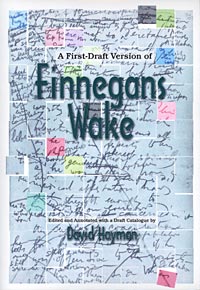Dhr. Seven (ed.), Wisdom Quarterly; Alison Flood (Guardian); Goodreads; Rachel Nuwer; Chrisp
 |
| Guides to reading it could muddle the original, but Joseph Campbell wrote the key. |
 |
After 9,000 emendations to James Joyce's notoriously impenetrable novel, a "smoother" new edition is promised by scholars Danis Rose and John O'Hanlon (theguardian.com).
|
Thirty years' editorial labors produce "more comprehensible" Finnegans Wake
 |
| The Emerald Isle from the space alien's view |
Thirty years of work and 9,000 amendments later, a new edition of James Joyce's most perplexing novel, Finnegans Wake, is promising to provide readers with a smoother, more comprehensible version of the author's final work.
On its publication on 4 May 1939, a review of the book in The Guardian despaired of making sense of it. Pointing to a sample from the book -- "Margaritomancy! Hyacinthous pervinciveness! Flowers. A cloud" -- Reviewer B. Ifor Evans said that "the work is not written in English, or in any other language, as language is commonly known."
 "In 20 years' time, with sufficient study and with the aid of the commentary that will doubtless arise, one might be ready for an attempt to appraise it," he wrote. "Compared with this, [Joyce's earlier book] Ulysses is a first-form primer."
"In 20 years' time, with sufficient study and with the aid of the commentary that will doubtless arise, one might be ready for an attempt to appraise it," he wrote. "Compared with this, [Joyce's earlier book] Ulysses is a first-form primer."
Seventy years on, scholars Danis Rose and John O'Hanlon have reached the conclusion of 30 years of textual analysis.
Poring over the tens of thousands of pages of notes, drafts, typescripts, and proofs that make up, in Joyce's own words, his "litters from aloft, like a waast wizzard all of whirlwords," they have made 9,000 "minor yet crucial" amendments and corrections to the book, from misspellings to misplaced phrases, ruptured syntax, and punctuation marks.
 |
| Literary allusions in FW |
"I never thought I'd see this day," said Rose. "The complexity of the texts and the complexity of the social situation meant it was very, very difficult indeed, but we stuck with it and we got there.
"There were 20,000 pages of manuscript, and beyond that 60 notebooks, and beyond that it extended out into thousands of different volumes. It extends out and out and out -- what Joyce was doing was distilling in and in and in. To reach the text we had to follow him back, and it's a lot harder to go backwards than forwards."
The book of a lifetime?
 |
| Finnegans Wake -- the Rock Opera? |
 |
| A gathering of Irish redheads (Guardian) |
Even the opening line of the book is slightly altered. The original reads: "riverrun, past Eve and Adam's, from swerve of shore to bend of bay, brings us by a commodius vicus of recirculation back to Howth Castle and Environs."
 |
| Let's fly to Planet Crazy, everyone! |
 |
| Interview - Robert Amos - James Joyce & Finnegans Wake (literaryphotographer.com) |
.
Who is dreaming Finnegans Wake?
 |
| Dottir of her Father's Eyes (Mary & Bryan Talbot) |
Here's the text of Atherton's lecture, as given in A Wake Newslitter Vol IV no 5, October 1967.
'I do not wish to deny any of the theories which have been put forward as to the identity of the dreamer: they are all true up to a point. For, as I see FW it is everyone’s dream, the dream of all the living and the dead. Many puzzling features become clear if this is accepted.
'I do not wish to deny any of the theories which have been put forward as to the identity of the dreamer: they are all true up to a point. For, as I see FW it is everyone’s dream, the dream of all the living and the dead. Many puzzling features become clear if this is accepted.
 'Obviously we will hear many foreign languages: Chinese will be prominent if we know Chinese; German if we know German, and so on.
'Obviously we will hear many foreign languages: Chinese will be prominent if we know Chinese; German if we know German, and so on.
'The Wake never stops: the last sentence circles round to become the first and the whole work revolves to reflect the nature of the world of sleeping humanity which travels around with the dark side of the globe -- “the owl globe” (6.29), that is to say the dark side, where the bird of night flies, “wheels in view.” So it is that Shaun, about whom we are all dreaming, can be told, “thou art passing hence…ere the morning of light…to the inds of Tuskland…” (427.18), and we visit, or seem to hear from...America... More
A Reader's Guide to Finnegans Wake
For years, William York Tindall's Guide has been one of the valuable ways to approach the difficult writing and complex language of Joyce's Finnegans Wake. Over a period of 40 years, Tindall studied, instructed and, most importantly, learned from graduate students about Joyce's greatest literary masterpiece. He explores and analyzes Joyce's unexpected depths and vast collection of puns, allusions, and word plays involving over a dozen languages. Tindall's Guide not only updates past guides to Finnegans Wake, but also breaks down the formidable barriers that could discourage readers from enjoying the humor and brilliance of Joyce. More
What does the book mean?
Goodreads.com
Finnegans Wake is an experimental novel by James Joyce. Extracts of the work appeared as Work in Progress from 1928 to 1937, and it was published in its entirety as Finnegans Wake in 1939. The book is, in one sense, the story of a publican in Chapelizod (near Dublin), his wife, and their three children; but Mr. Humphrey Chimpden Earwicker, Mrs. Anna Livia Plurabelle, and Kevin, Jerry, and Isabel are every family of mankind. Languages merge: Anna Livia has "vlossyhair" -- wlosy being Polish for "hair"; "a bad of wind" blows -- bad being Persian for "wind." Characters from literature and history appear and merge and disappear. On another level, the protagonists are the city of Dublin and the River Liffey standing as representatives of the history of Ireland and, by extension, of all human history. As he had in his earlier work Ulysses, Joyce drew upon an encyclopedic range of literary works. His strange polyglot idiom of puns and portmanteau words is intended to convey not only the relationship between the conscious and the unconscious but also the interweaving of Irish language and mythology with the languages and mythologies of many other cultures. More
- American mythologist Joseph Campbell explains:
A Skeleton Key to Finnegans Wake: James Joyce's Masterwork Revealed
Since its publication in 1939, countless would-be readers of Finnegans Wake -- James Joyce's masterwork that consumed a third of his life -- have given up after a few pages and dismissed it as a "perverse triumph of the unintelligible" [or the greatest literary joke ever foisted on the reading public]. In 1944, a young professor of mythology and literature named Joseph Campbell, working with Henry Morton Robinson, wrote the first "key" or guide to entering the fascinating, disturbing, marvelously rich world of Finnegans Wake. The authors break down Joyce's "unintelligible" book page by page, stripping the text of much of its obscurity and serving up thoughtful interpretations via footnotes and bracketed commentary. A Skeleton Key was Campbell's first book, published five years before he wrote his breakthrough Hero with a Thousand Faces. More
This late-night reading group zipped through Finnegans Wake in seven short months
Rachel Nuwer (smithsonian.com,
An LA-based Finnegans Wake reading group recently buckled down and decided to spare themselves the dozen-year cliff hanger. More





































































































































































































































No comments:
Post a Comment